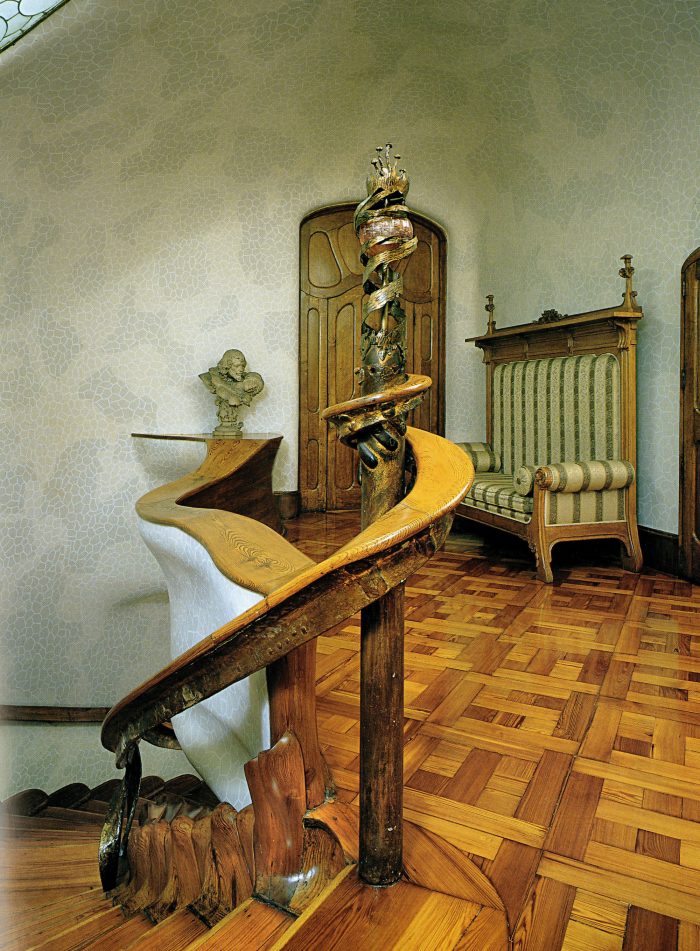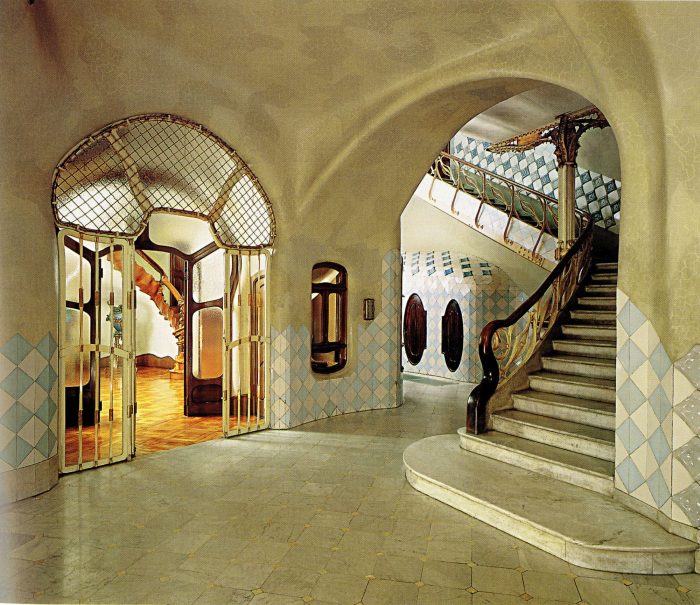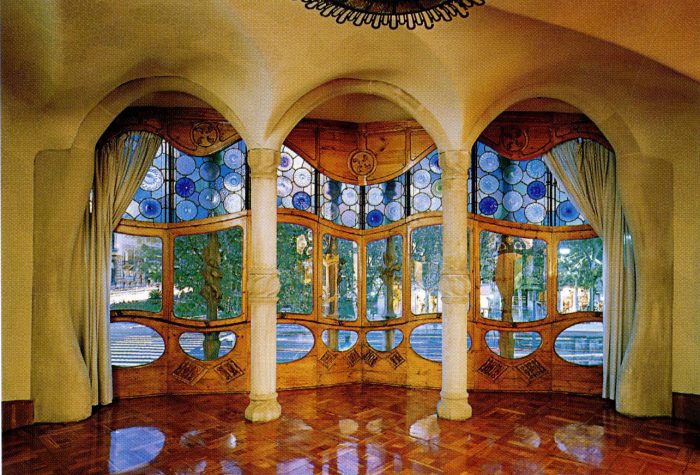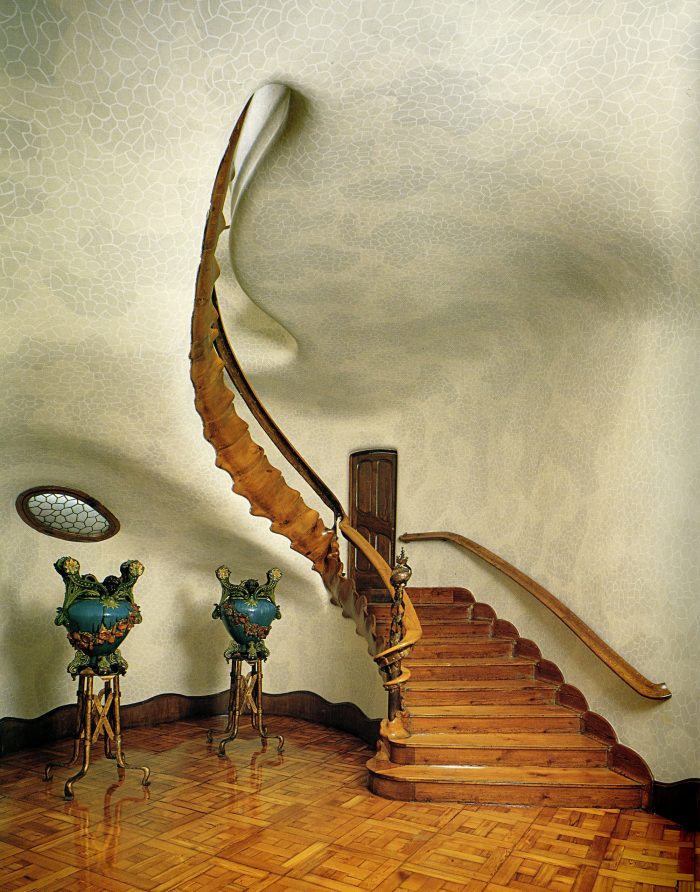安东尼-高迪富有灵感的想象力无疑体现在他最具诗意和艺术性的建筑设计之一–巴特洛之家。他将动物的形状、藤蔓般的曲线、骨架的暗示、以及他对釉面陶瓷和玻璃光泽的使用综合在一起,创造了一个永远令观察者震惊的杰作。
The inspiring imagination of Antoni Gaudí undoubtedly reveals itself in one of his most poetic and artistic designs for a building, Casa Batlló. His synthesis of animal shapes, vine-like curves, hints of bone and skeleton, and his use of lustrous colored bits of glazed ceramic and glass create a masterpiece that will forever astonish its observers.
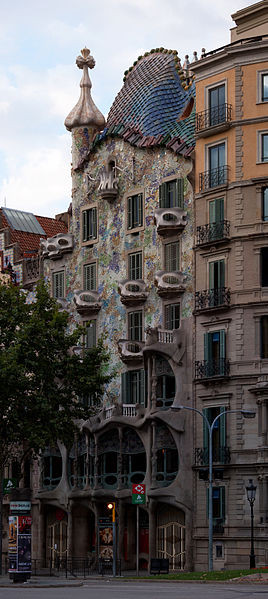

他的风格包含了新艺术派的所有定义,新艺术派是19世纪90年代法国装饰艺术家的一个流派,他们受到植物和自然界蜿蜒形状的影响。
His style encompasses all that defines the Art Nouveau, a School of French decorative artists from the 1890s who took influence from sinuous shapes in plants and nature.
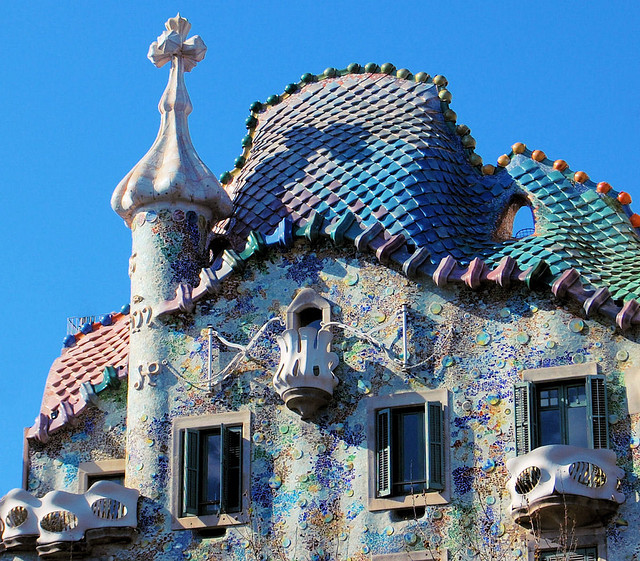
他在Casa Batlló探索了他对流动的形状、图案和色彩的兴趣,该建筑是为富有的棉花男爵Josep Batlló设计的,与周围僵硬的形式形成了强烈的对比。
He explored his interests in flowing shapes, patterns and colors in the Casa Batlló, which was designed for the wealthy cotton baron Josep Batlló as a jolting contradiction to the rigid forms that surround it.
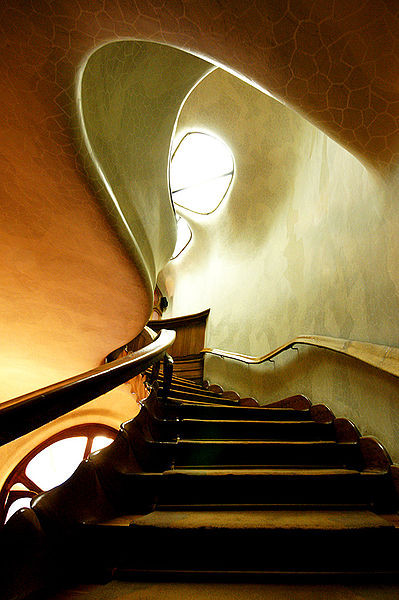
正面的外立面显示出醒目的纹理、色彩和意象,共同勾起人们对童话故事和幻梦的遐想。较大的雕塑作品创造了阳台的边界和入口处的框架,就像骨头一样,暗示着隔膜、眉毛或锁骨,保持着拟人化的基调。当目光游走到Casa Batlló的顶部时,迎接他们的是屋顶上霸气的爬行动物表面。
The front facade reveals striking textures, colors, and imagery that work together to conjure thoughts of fairytales and phantasmal dreams. The larger sculptural pieces that create the boundaries of the balconies and that frame the entrance resemble bones, suggesting a septum, eyebrows or clavicles, which keep to the anthropomorphic tone. As eyes wander up to the top of Casa Batlló, they are greeted by the dominating reptillian surface of the roof.
戏剧性的驼背丘 “一面覆盖着类似犰狳的铠甲,而另一面则覆盖着trancedis碎片,产生了微妙的白色到橙色的光泽。
The dramatic humpback mound “is clad on one side by armour plating resembling an armadillo’s, while on the other side it is covered with trancedis fragments producing a subtle white-into-orange sheen.
脊柱上点缀着绿色和蓝色的球状脊椎骨,暗示着这些可能是生物本身,而屋顶与外墙相接处的流动线条则用其他的萨乌尔骨骼和关节的铠甲来镶边。”
The spine is dotted with bulbous green and blue vertebrae, suggesting that these might be organisms in themselves, while the flowing lines where roof meets facade are edged with other armatures of saurian bone and joint.”
这种生物式的相似性在夜晚显得格外明显,当外立面以其骨质般的骨骼结构和戏剧性的阴影发光和萦绕。安东尼-高迪与一位名叫Josep Maria Jujol的纺织品制造商密切合作,他主要协助装饰和表面处理的色彩使用。
The creaturesque resemblance is made strikingly apparent at night, when the facade glows and haunts with it’s bone-like skeletal structures and dramatic shadows. Antoni Gaudí worked closely with a textile manufacturer named Josep Maria Jujol who assisted primarily in the ornamentation and use of color on the surface treatments.

在高迪的作品中,总是可以预料到,有一个反复出现的宗教意象,这几乎是在潜移默化中实现的。在建筑的上层以及外立面周围的小细节中,都植入了半隐蔽的宗教图像和文字。
As can always be anticipated in the works of Gaudí, there is a recurring religious imagery which is achieved almost subliminally. There are embedded and semi-concealed religious images and texts planted in the upper levels of the building, as well as in the small details around the facade.
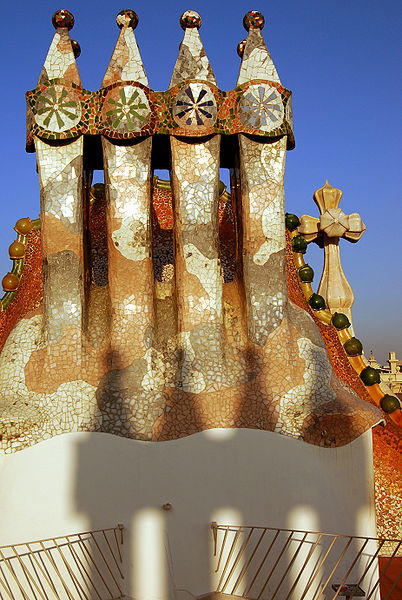
塔楼的最顶端坐落着高迪的标志性作品之一–一个四角横向十字架。吉尔认为,其目的是指出 “宗教可以拥抱幽默、幻想和荒诞”。它也可以被解释为向上帝传达的信息,即他是以上帝的名义建造的,而不是为了名声或财富的荣耀。
The very tip of the tower sits one of Gaudí’s signature pieces, a four-pointed transverse cross. Gill suggests that the goal was to point out that “religion can embrace humour, fantasy and the absurd.” It can also be interpreted as a message to God that he was building in His name, instead of for fame or glorification of wealth.
高迪最先进的中央供暖系统的使用,在当时的巴塞罗那是不常见的,因此通风口和烟囱是必须的。他把这里作为又一个扩展他的才华和想象力的地方,为Casa Batlló的童话结构和外观增添了色彩。这些烟囱最吸引人的地方之一,是它们在成为垂直的烟囱之前,与屋顶呈45度角。
Gaudí’s state of the art use of central heating, uncommon in the time and place of Barcelona, made air vents and chimneys necessary. He took this as yet another place to expand his talents and imaginations, adding to the fairytale structure and appearance of Casa Batlló. One of the most intriguing aspects of these chimneys are their 45-degree angle departure from the roof before they become vertical.
作为一个艺术家和全方位设计的信徒,细节和材料的强度并不只停留在外观上,这一点也不足为奇。
As an artist and believer in an all-encompassing design, it is unsurprising that the intensity of detail and materiality is not left to the exterior alone.
室内的设计或许更加细致,延续了蜿蜒流动的墙面和边缘,以及色彩的处理和不可思议的尺度变化。
The interior is perhaps even more detailed and designed, a continuation of the sinuous flowing walls and edges as well as color manipulation and incredible varying of the scale.
室内和从街道上看去一样有生命力;旋钮式的脊柱通过流动的墙面形式的鳞片状表面,将楼梯线条化。 在门、框架、窥视孔、模具和屏风等装饰特征中表现出的蜿蜒和扭曲,都是对自然形态的诠释,这也是高迪新艺术风格的灵感来源。
The interior is just as alive as it appears from the street; the knobbly spine lines the staircase through flowing wall forms of scale-like surfaces. The winding and twisting exhibited in the decorative features of doors, frames, peepholes, moldings and screens are all interpretations of the natural forms that inspired Gaudí’s art nouveau style.
正如安东尼-高迪本人所说:”那些寻找自然法则作为新作品支撑的人,就是在与创作者合作”。
As said by Antoni Gaudí himself, “Those who look for the Laws of Nature as a support for their new works collaborate with the creator.”
建筑师:Antoni Gaudí
年份:1906年
照片:Wikipedia, Ignasi de Solá-Morales, John Gill
Manufacturers: Parquets Nadal
制造商:Parquets Nadal
城市: BARCELONA
国家:西班牙
Architects: Antoni Gaudí
Year: 1906
Photographs: Wikipedia, Ignasi de Solá-Morales, John Gill
Manufacturers: Parquets Nadal
City: BARCELONA
Country: Spain


